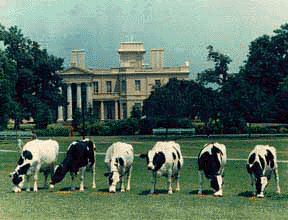
Index

Burial Plot of Sir Allan MacNab
Battery Lodge and Ornamental Gate
Plaques, Monuments and Objects
At the beginning of the 19th century, the area 250 feet above the waters of Burlington Bay, that would later become Dundurn Park and Harvey Park, was known as Burlington Heights. Colonel Richard Beasley (1761-1842), a pioneer, Hamilton merchant and politician, was the first person officially to own Burlington Heights in 1799. Beasley had been in the Hamilton area since at least 1793, and was an early settler of Hamilton. The Colonel built his first home, a log house, on the ridge between the present day Harvey Park and Dundurn Park. He also added a wharf, storehouse, barns and other buildings to the surrounding area. The front of his second house, made of brick, would later become the front wall and door of Dundurn Castle.
The shape, form and location of Burlington Heights made it a perfect natural stronghold during wartime. For this reason, Beasley had to house the British soldiers manning the earthworks in today's Harvey Park and Hamilton Cemetery during the War of 1812. The soldiers lived in his home on the Heights for 2 years and three months, and caused a lot of damage during their stay. Beasley later sued the government for losses, but did not recover any money.
Beasley lived on the land for a total of 33 years, and then sold the 395.02 hectares (976 acres) to his cousin and trading partner, John Solomon Cartwright, in 1832. The same year, Sir Allan Napier MacNab bought the site from him for $12,500. MacNab was to become a member of parliament for the County of Wentworth and the City of Hamilton, and the speaker for the first Canadian parliament. He was also the first prime minister for the Province of Canada in 1854.
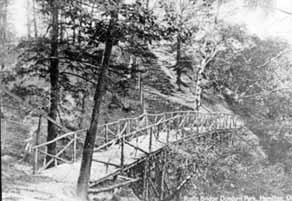
MacNab made many changes to the Dundurn property while he owned it from 1832 until his death in 1862. He built the many beautiful buildings and structures that still stand there today, such as the Castle, Cockpit Theatre, Coach House and Gardener's Cottage. With the help of his gardener, William Reid, he pulled down old barns and farm buildings, planted grass and trees into the plowed fields, created new driveways and roads, and completely changed the surrounding landscape. The Heights farmland took on the look of Scottish manor grounds.
In 1870, the MacNab Family offered the Dundurn land to the City for $17,500. When the City decided not to buy it, a southern woman named May bought it the following year for $20,000. This was the first of several offers to buy Dundurn that the City would refuse. For the next 30 years, citizens and politicians would always find a reason why the land should not be bought whenever it was offered.
For instance, at one time it was thought that when the City bought it, the land would be resold for a hotel, theatre and dining hall, or convent. Some residents of East Hamilton said that it was not fair that West Hamilton should get an expensive park, if they were not going to get one too. Rumours spread through the City that only rich people would be allowed to use the park. At one time, an alderman even claimed that the soil at Dundurn was full of a disease called ague, today known as malaria.
The City refused a second offer to buy Dundurn in 1872. Senator Donald MacInnes, later director of the Canadian Pacific Railways, bought it instead for $27,000. The third offer to the City came from MacInnes in 1877 for $75,000. While the City still refused to buy Dundurn Park, it did offer him the Crystal Palace grounds (Victoria Park) on a trade. However, the citizens of Hamilton did not want to lose the Palace grounds, and Senator MacInnes did not want to pay any money to pull down the old buildings that still stood there.
Dundurn Park finally gained real popularity with Hamiltonians after this third offer, when MacInnes opened his own Dundurn Park to the public on July 27, 1878. The Hamilton Times and Hamilton Spectator advertised the opening day in advance, as something new and fantastic. The park was surrounded by a high fence, and visitors had to pay to enter. The Hamilton Street and Railway contributed $150 worth of chairs to the park to make concerts and plays more enjoyable.
During those years, many festivals and events took place on MacInnes' grounds. Five days after the opening, the Buffalo Saengerbund held a German song festival for a great crowd of 2,000. Sir John A. MacDonald gave a speech there in 1882. In the summers of both 1882 and 1883, over 50 different clubs and associations rented the Dundurn grounds for parties and gatherings. Dundurn was home to baseball in the 1880's, because the Hamilton Clippers played on a baseball diamond there as part of the Canadian Baseball League. In August 1885, Hamilton was introduced to a new and exciting ride at Dundurn called the "roller coaster". The public enjoyed a re-enactment of the Siege of Sebastopol in June 1897, and one and two mile bicycle races one month later.
Then, in 1899, McInnes revealed a plan to sell the Dundurn land in city lots for workingmen's cottages. The public voted on a by-law to buy the 12.55 hectares (31 acres) at Dundurn on September 8, 1899. The bylaw was passed with 2016 votes for buying the park, and 914 against it. Although MacInnes asked for $75,000 for the land and buildings on it, he and the City eventually agreed on a price of $50,000. The City gave its final approval of the sale on October 2, 1899.
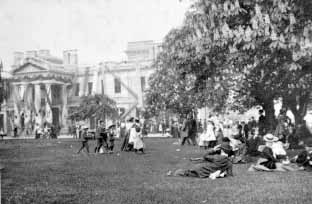
Opening day for the public Dundurn Park was on Queen Victoria's Birthday, May 24, 1900. The opening celebrations were the biggest in Canada for the time, and among the biggest that Hamilton had ever seen. Almost everybody from 20 miles around, as well as guests from Woodstock, Paris, St. Catharines, Niagara Falls, Grimsby and Buffalo, came to watch the special events. The opening day programme included a parade, a school choir concert, fireworks and other exciting events.

Over the years, private businesses have tried to make money from Dundurn Park's popularity and great location. Right after the City bought it, businesses began to ask to use pieces of the property. In 1900, the same year of the opening, the Cataract Power Company wanted to put a Hamilton-Galt-Guelph power line through the lower end of the park. Railway companies tried to have tracks put through the grounds in 1907, 1916, and again in 1959. In 1929 the Hamilton Street Railway wanted to use a part of the park for a street car loop. Several times, American companies showed interest in Dundurn for amusement parks and hotels. In 1960, the Chedoke Expressway was almost built straight through the park to meet Barton St. Fortunately, protective citizens and officials have always fought against these plans, so that all the above and other requests were denied.
While a war has not been fought near Dundurn Park since the War of 1812, police received reports of soldiers taking Dundurn Castle in May 1989. However, the men with rifles seen running through Dundurn Park that night turned out to be the Royal Hamilton Light Infantry. They had received permission to use the grounds for a military exercise, as long as their guns were not loaded.
In 1992, the Ministry of the Environment recognized the Dundurn landscape for its national importance as a restored 19th-century park. In 1993, the Ontario Heritage Foundation gave Dundurn Park a two year grant to study the possibility of replanting the kitchen garden.
Today, many modern festivals and celebrations have been moved from Dundurn to newer parks such as Gage Park, Bayfront Park and Princess Point. However, Dundurn Park is still used for historic festivals and shows, such as Victorian picnics and crafts, re-enactments of various historic battles, Scottish celebrations, Gaelic dancing and historic band concerts.
As a part of the harbourfront redevelopment project, plans eventually are to connect Bayfront Park and the harbourfront to Dundurn Park with a path or bridge. While this may seem like a very new idea, on two occasions in the 1920's, a bridge and then tunnel were almost built to connect Dundurn Park to a waterfront beach on the rail yard. However, CN Rail, and the railway company that owned the yard before it, would never permit construction of any structure over or under their property.

Sir Allan MacNab died August 8, 1862. He was buried to the east of the Dundurn property, near Tecumseh St. on a plot called Inchbuie overlooking the bay. In the grave next to him lay his first wife, their son, his second wife, and other family members that had passed away. The whole plot was surrounded by a square brick wall and iron railings, and was entered by an iron door.
In 1908, Mrs. French, grand-daughter of Sir Allan MacNab, donated this little MacNab cemetery to the Parks Board. In 1909, the graves in the little cemetery were removed and the remains reburied. Seven graves were moved to the Protestant Hamilton Cemetery, while eight graves, among them MacNab's, went into an unmarked grave in the Roman Catholic Holy Sepulchre Cemetery. A marker was later placed on the site.
Mrs. French put one condition on the donation of the land. The Board was to spend $800 for a monument in the burial plot and other improvements that she would approve. However, Mrs. French and the Board could not agree over some of the costs involved. In protest, Mrs. French stopped the transfer of her land to the City, and sold the area to someone else for $2,500. Eventually, the City did manage to buy the 0.57 hectares (1.42 acres) of land for $8,000 on July 25, 1925.
After buying the Burlington Heights property from Cartwright in 1832, MacNab began plans to build himself a grand new home. He chose to build a smaller copy of his family mansion, Dundurn, located in Loch Hearn, Perthshire, Scotland. Dundurn means "Fort of a fist" in Gaelic, because the castle in Scotland is built on a rock, making the castle look like it is pointing up and out of the surrounding flat land like a fist. The architect Robert Charles Wetherell drew the Canadian version of the castle, and added the Cockpit Theatre, Coach House and other buildings to the plan of the surrounding area.
Dundurn Castle is not really a castle, but a Regency period Tuscan villa of brick and stucco. The building just looks like a castle because it has twin watch towers. Finished in 1835, it was the first European style mansion built in Ontario, and the biggest building ever built in Upper Canada. The cost to finish the mansion, $175,000, was very high for the period, and gave MacNab financial difficulties. To earn some extra income for the project, he printed a newspaper advertisement offering to rent the brick house Beasley had built. However, unfortunately, no one wanted to rent the place. The money problems from the expense of building Dundurn Castle would later return to him from time to time throughout his life.

On the outside, the stucco of the house was etched and finished to look like limestone cut from the Hamilton Mountain. In 1855, under the leadership of the architect Frederick Rastrick, a portico, a little roof on six marble pillars, was added to the front of the house. This was done to improve its look, because the mansion was considered plain and boring from the front. In fact, until the portico was built, almost all drawings of the Castle had been made of the back of the house, because it was considered the pretty side.
The Castle contained 72 rooms and 17 fireplaces. Special features were the mosaic hall floor, Greek moldings, grand staircase and a recreation hall, which later held Canada's first bowling alley. Some people, who have lived and worked in and around Dundurn over the years also claim that at least three secret tunnels used to link the Castle to the Battery Lodge, the bayfront, and the earthworks in the Hamilton Cemetery across the street. However, no one has ever been able to prove that these tunnels really exist. No photos have ever been taken of them, and archaeological digs have not uncovered any passages.
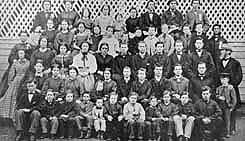
Two years after MacNab's death in 1862, Professor John Barrett McGann, "the pioneer of deaf-mute education in Ontario", moved the 55 students of his Provincial (sometimes called Upper Canada) Institution for the Education of the Deaf and Dumb from Toronto to Dundurn Castle. Prof. McGann taught deaf and mute students there until 1870, when the school moved again to Belleville. Later, William Stroud, "the father of baseball in Canada", would live in the Castle with his family for summers in the 1880's and 1890's.
After the City bought the park in 1899, the Wentworth Historical Society suggested that Dundurn Castle be used as a museum, and not as a dance pavilion as others had suggested. The Castle was approved for museum exhibitions from 1900, but opened as an official museum only in 1935. The museum closed when Castle restorations began for the 1967 Centennial celebrations.
The first efforts to restore the Castle to a time period in which Mac Nab would have lived there, began in the late 1950's. Eaton's Department Store donated decorations in 1850's style for MacNab's bedroom in the summer of 1957. Another bedroom was redone the following summer, and the nursery, smoking room and dining room were added to the list in the next five years. Then the architect and consultant, Anthony Adamson, suggested that $167,000 would be needed to develop the historic value of the Castle in renovations for the 1967 Hamilton Centennial celebrations. Later, in a second report, he increased this figure to $465,000, at $257,000 for building needs, and $107,300 for decorations and furniture.
While almost everyone supported the idea to renovate the Castle (although one alderman thought that repairing sidewalks was more important), it was very difficult to find enough money to do it in the City budget. Eventually, the municipal, provincial and federal governments each gave the Hamilton Centennial Committee a third of the $465,000 needed.
The following four-person committee led the Castle restoration:
- Prof. Anthony Adamson, Dundurn general consultant, author, University of Toronto town planner;
- Mrs. Jeanne Minhinnick, Dundurn technical advisor, Upper Canada Village designer;
- Mrs. Gwen Metcalfe, Dundurn curator;
- Mrs. Marion MacRae, historical researcher and restoration expert.
Work began July 1, 1964, and lasted 3 years.
During the renovations, the restoration architect, Arthur W. Wallace, often referred to the diary that Sir Allan MacNab's daughter, Sophia, had written. The book held many descriptions and details of how the Castle looked in 1855. Many changes took place, but one such change did not occur because of protests from the public. In January 1966, the committee suggested that the portico should be removed from the front of the Castle. The wood inside had begun to rot, and the whole structure had been built about 10 years after 1855. Mr. Wallace suggested it could be rebuilt somewhere else as a monument, perhaps at MacNab's burial site. However, the public wrote many letters saying that although it was from the wrong period, to them it was an important part of Dundurn, so the portico stayed.

Outside of the Castle, other local groups and individuals got into the Centennial spirit by helping the renovators. In 1966, the Head-of-the-Lake Historical Society sold plates for $2 each to get extra funds for the project. CHCH Channel 11 publicized the restoration in a documentary shown in May 1966. The Hamilton Spectator donated $30,000 to renovate the Cockpit Theatre. John Labatt Ltd., brewers of Labatt beer, provided all the old beer making pots, pans and tools for a little basement brewery free of charge. As with the museum before it, the Castle was decorated thanks to many personal donations of antiques and cash.
On January 1, 1967, the Dundurn Castle Committee took over managing the renovated Dundurn Castle from the Wentworth Historical Society. The committee was made up of one controller and one member from the Parks Board, one City alderman, and four citizens chosen by the City Council. In February 1967, the first committee was present to receive the Sword of Honour, originally given to Sir Allan MacNab by the Men of Gore in 1841, from Lord Albemarle, the great-grandson of Sir Allan MacNab. The sword became an important exhibit for the restored Castle.
Dundurn's old bronze bell, 18" in diameter, 15" high and dated 1836, had left the grounds a few years after MacNab's death, when his sister-in-law had donated it to the Sisters of St. Joseph convent. As one of three special Centennial projects, 1,467 students from Barton Secondary School collected donations to buy a similar bell from an old Taro schoolhouse 12 miles from Owen Sound. They hoped to trade it with the Sisters for the real Dundurn bell. However, as this was not possible, they donated the Taro bell to Dundurn in April 1967. Students at Ainslie Wood and Albion vocational schools built a turret to hold it in June 1973. The bell was finally hung at the Castle in May 1977.
The newly renovated Dundurn Castle opened its doors at 2:30 p.m. on June 17, 1967, to a crowd of 3,000. Premier Robarts and the chieftain of the MacNab clan (sometimes called "the MacNab"), Archibald C. MacNab, were present. A $28,000 campaign advertised the event in Southern Ontario within 200 miles of Hamilton. The celebrations included a play opening the renovated Cockpit Theatre, the unveiling of a grave memorial to Sir Allan MacNab, a tree planting program, a regatta, a rose show, fireworks, a picnic and square dancing competitions.
In July 1967, attendance averaged 1,000 daily, with an average of 2,000 people visiting on Sundays. The Hamilton Spectator described the Castle as "Hamilton's own Taj Mahal, Louvre and Hampton Court rolled into one majestic, elegant, tourist-pulling package." Evening hours were added in September to keep up with the demand of visitors. All together, about 115,000 people visited Dundurn Castle in 1967, and 130,000 in 1968.
Dundurn Castle was finally designated a national treasure under the Ontario Heritage Act in August 1977. Then in November 1982, the Province approved the property for public use, so that parts of the Castle and park could be used for private parties and weddings. However, just six years later federal funding restrictions cancelled this permit.
In 1993, $1.7 million was approved for outdoor renovations on the Castle, as the 1967 renovation had concentrated mostly on the inside of the Castle. During the clean-up, several boarded windows and doors were found under the stucco, including a pair of walnut French doors in perfect condition.
In October 1993, Dundurn Castle was honoured internationally, when the American Association for State and Local History recognized it with a Certificate of Commendation for the preservation of local history.
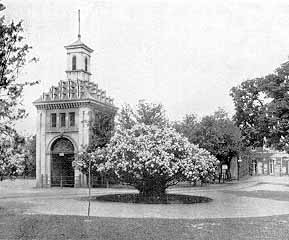 The Dove Cote, built in 1835, is a type of towering pigeon coop rarely found in North America. Each of the four slanting roofs of the building has twelve doors with perches, that lead to over 100 pigeon stalls inside the cote. The Castle's cook would get pigeons from the coop to use for fresh meat during the winter.
The Dove Cote, built in 1835, is a type of towering pigeon coop rarely found in North America. Each of the four slanting roofs of the building has twelve doors with perches, that lead to over 100 pigeon stalls inside the cote. The Castle's cook would get pigeons from the coop to use for fresh meat during the winter.
The bottom floor of the Dove Cote was used to park Sir MacNab's carriage. Over the door is a carved stone head, the MacNab family motto, "Gun Eagal" ("Without Fear" in Gaelic), and the year the building was built.
Recent renovations to the Dove Cote include a new cupola and lightning rod on October 28, 1995.
The Coach House was built at the same time or slightly later than the Castle in the 1830's. The building was used to house the horses and other farm animals used at Dundurn for transportation and in farming. The MacNab Family's male servants, except for the butler, lived in the Coach House. This kept them separate from the female servants, who slept in the Castle basement.
After the 1967 restoration, the Coach House was used as a popcorn and soft drink stand. The building is being rebuilt, and will hold the gift shop and a restaurant by the fall of 1996.

For many years people thought that the Battery and Ornamental Gate were built for the War of 1812. However, only the spot on which the structures were built, called the earthworks, was used for the main cannon during battle. The stucco and brick Battery Lodge and Ornamental Gate were built later after the Castle and Cockpit Theatre, around 1837. The Lodge was meant as a home for MacNab's gatekeeper, and later the MacNab children's tutor, Mr. Thompson.
Beginning in the 1920's, the City fought a 50 year battle over the historic importance of the Ornamental Gate and Battery Lodge. People have generally had one of two opinions on the Gates and/or Battery Lodge:
a) that they should be pulled down, because they block the view of York Blvd. for drivers, or
b) they should be saved at all costs because of their historical importance.

The arguing ended on March 23, 1976, when workers began slowly to move the Battery Lodge to a new location. The building was secured with steel beams that kept the 13 inch walls together. Over one week, the 250-ton building was pulled with rollers on wood beams to the new spot 40 metres (150 feet) north from its original location. The Battery was also turned 30 degrees over two or three days, and then set on a new foundation and basement. The old Ornamental Gate was completely removed, because it was in very bad shape, but a new copy was built on the pedestrian pathway to the Castle. The City then widened York Blvd. to three lanes in each direction, and removed a dangerous curve in the road.
Today, at its new location, Battery Lodge houses the Hamilton Military Museum.
The Cockpit Theatre is an eight-sided room lined with benches. Originally built for cock fighting, it was built into the side of the ravine leading to the bay in 1835. After cock fighting was banned in 1847, it is not really known in what way the MacNabs used the building. Some say Sir Allan and his male friends used it for private parties with special female visitors after hunting trips. Others have suggested it was a boat house, or Lady MacNab's chapel.
During the years the Dundurn Zoo was open, some of the buffalo were kept in the Cockpit Theatre, as well as in the basement of the Castle. When the buffalo were moved, the Theatre was boarded shut for many years, because of its age and the work of vandals.
In 1965, an amphitheatre for 1,000 people was built around the Cockpit for the Sound and Light show. In 1966, the Hamilton Spectator donated $30,000 to restore the outside of the cockpit, and to renovate what would become Hamilton's first outdoor theatre with dressing rooms, electrical equipment and a stage. To open the renovated Cockpit Theatre for the Centennial celebrations in June 1967, the Players' Guild of Hamilton offered a play called "Thy Son's Command" by Dr. Arthur Murray. The Studio Theatre, Piccadilly Circus, Dr. Bandoli's Travelling Good-Time Show, and other theatrical and musical groups staged children's plays and held starlight concerts at the Cockpit Theatre from 1968 to the 1990's.
In 1992, a group of archaeologists worked around the base of the Cockpit Theatre. Underneath they found the foundations for a single storey log cabin, 6m X 8m (20 X 25 feet), with wood floors and glass windows, that used to belong to Colonel Richard Beasley. This was a great discovery, because until then no one had known exactly where Beasley's log cabin had been located.
In December of 1993, the vent stack, which had been removed in the 1940's, was rebuilt on the roof of the Theatre. The building was restored to a cock pit, and reopened July 26, 1996. However, because cock fighting is illegal in Canada, it is not actually used.
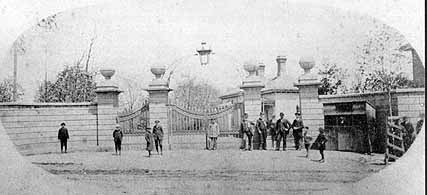
The Dundurn Gates were not built for the Dundurn property, but once belonged to George Rolph, a lawyer and veteran of the War of 1812. He bought a 121.42 hectare (300 acre) property in Dundas, now the location of the Dundas Driving Park, on May 14, 1822. He had the gates built for the south entrance of the maple avenue, that led to his large log house.
The stone used for the gate posts and the high wall that extended to each side came from the Sydenham Mountain Quarry located on the north boundary of Mr. Rolph's land. An inscription still visible on the gate tells us that the stone balls and pillars of the posts were carved by "John Allan, stone-cutter, Staffordshire, England, emigrated to Upper Canada in 1820. In 1828 he constructed these pillars and erected this monument, 'that he lived and will die a faithful subject of his King and country, and proud of his national birth." The metal gates between the stone posts were ordered from a British foundry.
Apparently Mr. Rolph had planned to build a mansion in a similar style as the gate, but a death in the family changed these plans. Instead, he sold the gates to Sir Allan MacNab, who had told him earlier that he liked them very much. They were moved to the end of the drive at Dundurn in 1854-5.
By 1931, the gates had become too narrow for regular car traffic. To widen them, the inner pillars of the gate were moved to Chedoke Golf Club in 1931. They were returned to Dundurn in 1976, when the whole gate was rebuilt and moved to stand at the end of the driveway to the parking lot.
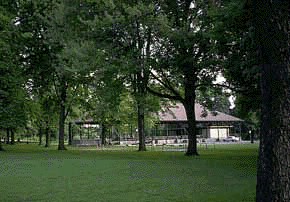 The Pavilion was built as a shelter for picnickers in 1906. A baseball diamond with a covered L-shaped grandstand stood on the same site from the 1880's until about 1902. Before that, at least one of MacNab's vegetable or formal gardens was located on the same spot.
The Pavilion was built as a shelter for picnickers in 1906. A baseball diamond with a covered L-shaped grandstand stood on the same site from the 1880's until about 1902. Before that, at least one of MacNab's vegetable or formal gardens was located on the same spot.
In May 1947, Mr. F. G. Bourne got permission to use the Pavilion as a dance hall on behalf of two orchestra leaders, Neil Golden and Morgan Thomas. Dance music was offered from a new bandstand five and sometimes six nights a week at $0.50 on week nights, and $1.00 on weekend nights. When attendance eventually decreased during the week, some evenings roller skating was offered instead of dancing.
In 1948, the Pavilion got a bad reputation. The newspapers reported that an Afro-American man was not allowed to enter the pavilion for no particular reason. People picketed the dance hall, causing attendance to drop about 50 %. Gangs had already begun to go to the Pavilion looking for fights. On the evening of September 6, 1948, 125-150 youths in groups of 15-20 almost started a riot with empty bottles and knives. Only the 25 police officers who stood around the Pavilion stopped the fighting, in which 50 men were injured. In July 1952, the police stopped another similar fight before it even started, because they had heard a rumour about it ahead of time.
In March of 1953, the City decided not to renew the lease for dancing at the Pavilion. The Spectator reported that: "In a letter to the committee, which was read at the meeting, a duty constable described Dundurn Park as 'a meeting place for teenage thugs,' and went on to say that, since the pavilion had been used as a skating rink, the police patrol had been increased, 'and only by this are fights and disturbances avoided.'" The Pavilion was returned to its only use for picnics.
In September 1969, the Ontario Municipal Board approved a $80,000 loan to fix the Pavilion roof and lights (about $20,000), the band shell ($5,000), and build new washrooms and a refreshment booth ($55,000 together).
In the winter of 1992, a City Council report suggested that in future, the Aviary and Pavilion could be moved to another location. According to the restorations being done at Dundurn, they did not exist in 1855.
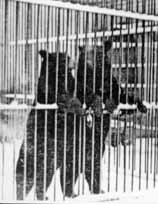 When the City bought the park in 1899, it was decided that, like any big park in a big city, it needed a zoo. A local shopkeeper started the City's animal collection with the donation of two black bears, Joe and Pete, the same year. Other animal donations such as exotic birds, monkeys and a lion soon followed.
When the City bought the park in 1899, it was decided that, like any big park in a big city, it needed a zoo. A local shopkeeper started the City's animal collection with the donation of two black bears, Joe and Pete, the same year. Other animal donations such as exotic birds, monkeys and a lion soon followed.
Hamiltonians enjoyed their Zoo for its first 10 years. However, soon people started to complain that it was becoming dirty, and that the animals were being treated poorly. The lion was forced to live in a 2 by 4 foot cage. In May 1913, garbage had started to pile up in and around the animal cages. A California alligator almost died in February 1914, when the water in its cage froze to ice with him in it. Most of the animals looked unhealthy and underfed. Rats lived in the cages with the animals, where they had a good supply of animal food and bird seed for their own needs. Drivers complained that the Zoo took up too much space from the road through the park.
By November 1920, the Parks Board had decided that the Zoo would have to go. At the time, the Zoo held one black bear, a lion, a coyote, several monkeys, black squirrels, chipmunks, and deer. Buffalo, led by the head buffalo, Old Bill, were also kept in the Cockpit Theatre and the cellar of the Castle. Only a few birds still existed, because those that had been donated by Dr. T. S. McGillivray, Harry Fearman and others, had already died. However, as the City budget did not have the funds needed to do the expensive move, the Zoo stayed open.
Conditions at the Zoo got worse. In 1921, the star attraction, Leo the Lion from Leon Washburn's circus, died. In November 1924, Jacko, a male African monkey killed Rosa, a female monkey of the same species, after she was added to the cage in which Jacko and Mrs. Jacko were already living. In 1922, the 15 black squirrels did find new homes. However, they were simply freed from their cage in hopes that they would stay to live in the Dundurn park trees and feed themselves. Only one squirrel actually stayed, while the other 14 were reported to have spread out over the city. In fact, most of the black squirrels in Hamilton today come from those first squirrels originally released at Dundurn Park.
In May 1926, the Parks Board finally found the money to move the animals and replace the Zoo with an aviary. The money came from Mr. Thomas Gould's 1919 donation of $3,000 meant to make the Zoo more attractive. The Zoo closed to the public in April 1928. The animal cages were remodelled, and re-opened as the Dundurn Aviary in April 21,1932.

In 1992, the City cut the Aviary budget to $17,000, suggesting Dundurn administration find volunteers to care for the birds. At the time, the Aviary had over 1,000 birds of more than 50 different species, including finches, doves, peacocks, lovebirds, budgies, cockatiels, cockatoos, parrots, pheasants, Brazilian cardinals and other birds. Of these birds, the scarlet macaw and two types of cockatoo needed particular attention, because they are endangered species. The unions protested the loss of the full-time bird keeper, and many believed that Aviary volunteers would be hard to find.
However, at the end of June 1992, following advertisements in the newspapers looking for volunteers, over 40 interested people helped establish the Friends of Dundurn Aviary Committee. Many were from the Cage Bird Society of Hamilton and the Hamilton and District Budgerigar Society. They took on duties that included everything from cleaning cages, to talking to visiting students. They also started their own newsletter, filled with interesting bird information and facts.
Two weeks after the Aviary had received all this media attention about the volunteer committee, someone broke into the Aviary at night, and stole Gigi, the scarlet macaw, an endangered species. Fortunately she was not hurt, and a local resident found her wandering down the sidewalk on York Blvd. two days later. She was returned to the Aviary safely.
In 1995, the Aviary's 700 birds from about 57 species had to be moved out of Dundurn for renovations to the Castle. The move also allowed the Castle maintenance crew to kill the colony of about 2,000 mice that had been living off the bird food in the Aviary since 1927. Several warehouses, Victoria Park and a greenhouse at the Hamilton Psychiatric Hospital were all considered for the birds' new home. On August 15, 1995, the birds were finally moved to the old and empty Kenilworth Avenue police station.
The Aviary had been added to the Castle later than the 1855 restoration period, therefore, it was decided that the birds would not be moved back to Dundurn once renovations were done. As their temporary home at the Kenilworth Avenue police station was only available until May 1996, a final home was found for them in the new Churchill Park Community Gardens. The City is leasing the Gardens, originally the Children's or Teaching Gardens, from the Royal Botanical Gardens for a five year period. A building at the end of the Gardens greenhouses, rebuilt into a new aviary with outdoor cages, now houses the birds.
The Gardener's Cottage - The two storey brick house was built at 25 Tecumseh St. from 1856 to 1857 for William Reid, the Castle grounds gardener. A stream that emptied into the bay used to separate it from Castle Dean on Locke St. N. The cottage has a wide door, five windows on the front of the house, and a fireplace in every room. The MacNab family sold the building to a railway engineer, Joseph A. Nelligan in 1907. He later sold it to Thomas J. Baker in 1911. Mr. Baker's daughter inherited the house, and lived there until she died in 1991. When the Gardener's Cottage went on the market, the City approved its purchase on October 8, 1991. A historic plaque was unveiled at the building by the Hamilton Historical Board on October 1, 1983.
Castle Dean (also known as Castle Dounne and St. Mary's Lodge)
The first part of the miniature medieval stucco and brick castle, located at 235 Locke St. N. at Tecumseh St., was built some time in the 1830's or 1840's. The Castle is believed to have been named either after the first estate manager named Dean, or the Scottish family "Dounne". The building contains a hall with high ceilings, a fireplace like the main one in Dundurn Castle, and a square turret and round bay room added in 1908. A stream that emptied into the bay used to separate it from the Gardener's Cottage on Tecumseh St. Castle Dean has been privately owned for many years by different owners. In 1952, the building was divided in half, and the original half was sold to a second owner. Both sides were rejoined under one owner in 1986. A historic plaque was unveiled at the building by the Hamilton Historical Board on September 24, 1988.
- Two British Nine Pounder Guns (cannons).
- Two British 24 Pounder Guns (cannons).
 - A 7 tonne German Howitzer Field Gun (cannon) - In 1987, Dundurn administration had decided to sell the Howitzer to the Liberty Memorial Museum in Kansas City, Missouri. They felt that, because it was getting old and rusty, it was becoming dangerous for the children, who liked to climb on it. The gun also did not match the historical period to which the Castle had been restored. The gun had been given to the City of Hamilton after it had travelled through Canada as part of a war prizes exhibit after World War II. News of the planned sale angered Hamilton war veterans and reserves. The 23rd Service Battalion of Hamilton organized a restoration project, and the Hamilton Artillery Association and Royal
- A 7 tonne German Howitzer Field Gun (cannon) - In 1987, Dundurn administration had decided to sell the Howitzer to the Liberty Memorial Museum in Kansas City, Missouri. They felt that, because it was getting old and rusty, it was becoming dangerous for the children, who liked to climb on it. The gun also did not match the historical period to which the Castle had been restored. The gun had been given to the City of Hamilton after it had travelled through Canada as part of a war prizes exhibit after World War II. News of the planned sale angered Hamilton war veterans and reserves. The 23rd Service Battalion of Hamilton organized a restoration project, and the Hamilton Artillery Association and Royal
 Canadian Legion raised funds to save the gun. The Howitzer was cleaned and repaired for $10,000 in materials, 1,000 free hours of repairs, and free transportation worth $2,500. The gun was returned to its Dundurn Park location by the Battery Lodge on November 7, 1987.
Canadian Legion raised funds to save the gun. The Howitzer was cleaned and repaired for $10,000 in materials, 1,000 free hours of repairs, and free transportation worth $2,500. The gun was returned to its Dundurn Park location by the Battery Lodge on November 7, 1987.
- A boulder with a metal plaque honouring the United Empire Loyalists and Confederation unveiled July 1, 1927, by the Historical Committee of the Jubilee General Committee.
- Two metal plaques honouring Sir Allan MacNab and Sir John Harvey unveiled July 30, 1958, by the Archaeological and Historic Sites Board of Ontario.
- A metal plaque honouring W. J. (Bill) McCulloch unveiled June 14, 1969, by Lieutenant Governor W. Ross MacDonald for his work as chairman of Hamilton's Centennial Committee, and in restoring Dundurn Castle.
- Two metal plaques honouring Sir Allan MacNab and Dundurn Castle unveiled October 4, 1986, by the Historic Sites and Monuments Board of Canada.
- A metal plaque honouring Allan Studholme (1846-1919) from the Ontario Heritage Foundation, unveiled at the Dundurn Pavilion on Labour Day, September 2, 1991, by the Hamilton and District Labour Council and the Head-of-the-Lake Historical Society.
